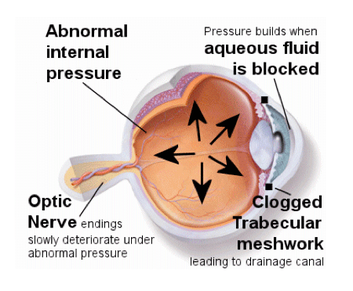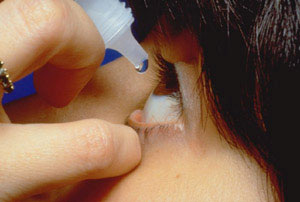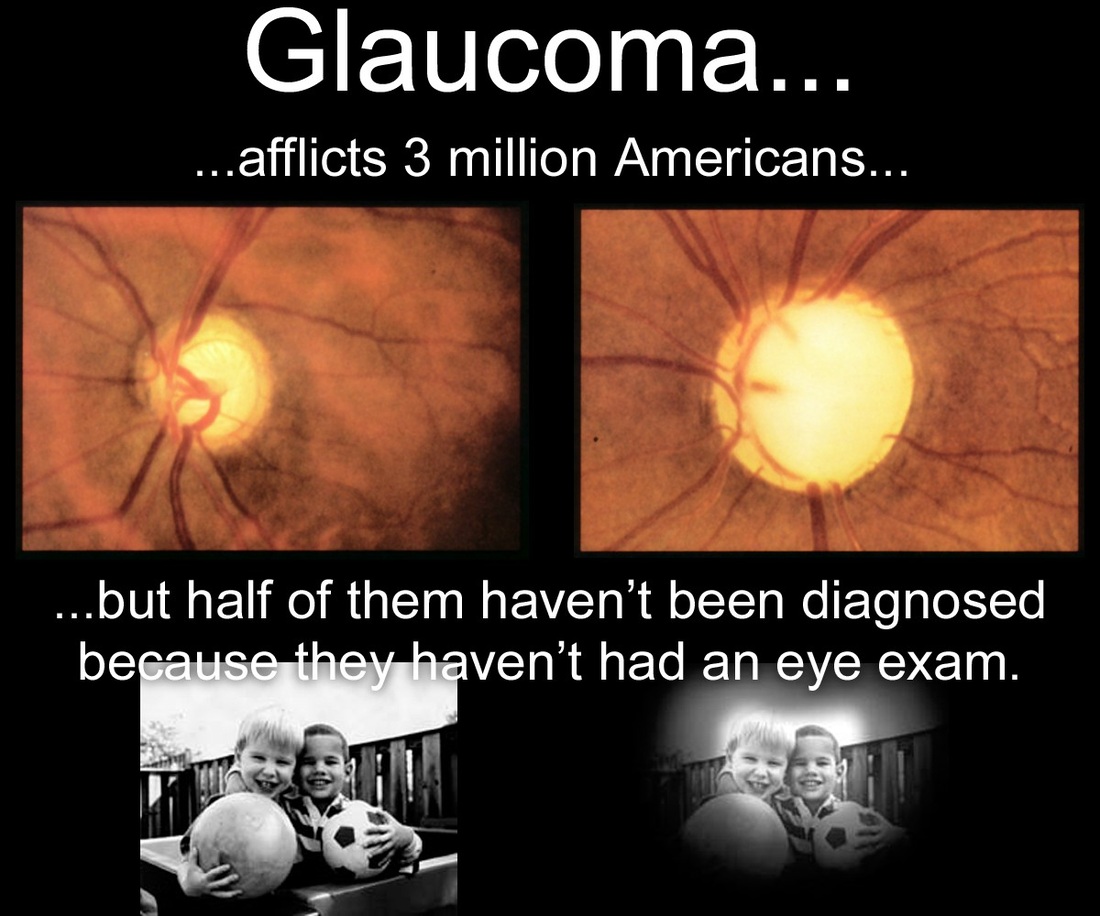What is Glaucoma?
|
Glaucoma is a group of eye disorders leading to progressive damage to the optic nerve, and is characterized by loss of nerve tissue resulting in loss of vision. The optic nerve is a bundle of about one million individual nerve fibers and transmits the visual signals from the eye to the brain. The most common form of glaucoma, primary open-angle glaucoma, is associated with an increase in the fluid pressure inside the eye. This increase in pressure may cause progressive damage to the optic nerve and loss of nerve fibers. Vision loss may result. Advanced glaucoma may even cause blindness. Not everyone with high eye pressure will develop glaucoma, and many people with normal eye pressure will develop glaucoma. When the pressure inside an eye is too high for that particular optic nerve, whatever that pressure measurement may be, glaucoma will develop.
Glaucoma is the second leading cause of blindness in the U.S. It most often occurs in people over age 40, although a congenital or infantile form of glaucoma exists. People with a family history of glaucoma, African Americans over the age of 40, and Hispanics over the age of 60 are at an increased risk of developing glaucoma. Other risk factors include thinner corneas, chronic eye inflammation, and using medications that increase the pressure in the eyes. The most common form of glaucoma, primary open-angle glaucoma, develops slowly and usually without any symptoms. Many people do not become aware they have the condition until significant vision loss has occurred. It initially affects peripheral or side vision, but can advance to central vision loss. If left untreated, glaucoma can lead to significant loss of vision in both eyes, and may even lead to blindness. A less common type of glaucoma, acute angle closure glaucoma, usually occurs abruptly due to a rapid increase of pressure in the eye. Its symptoms may include severe eye pain, nausea, redness in the eye, seeing colored rings around lights, and blurred vision. This condition is an ocular emergency, and medical attention should be sought immediately, as severe vision loss can occur quickly. Glaucoma cannot currently be prevented, but if diagnosed and treated early it can usually be controlled. Medication or surgery can slow or prevent further vision loss. However, vision already lost to glaucoma cannot be restored. That is why the American Optometric Association recommends an annual dilated eye examination for people at risk for glaucoma as a preventive eye care measure. Depending on your specific condition, your doctor may recommend more frequent examinations. |
|
What Causes Glaucoma?

There are many types of glaucoma and many theories about the causes of glaucoma. The exact cause is unknown. Although the disease is usually associated with an increase in the fluid pressure inside the eye, other theories include lack of adequate blood supply to the nerve.
Primary open-angle glaucoma – This is the most common form of glaucoma. One theory is that glaucoma is thought to develop when the eye’s drainage system becomes inefficient over time. This leads to an increased amount of fluid and a gradual buildup of pressure within the eye. Other theories of the cause of the optic nerve damage include poor perfusion, or blood flow, to the optic nerve. Damage to the optic nerve is slow and painless and a large portion of vision can be lost before vision problems are noticed. Other theories also exist.
Angle-closure glaucoma – This type of glaucoma, also called closed-angle glaucoma or narrow angle glaucoma, is a less common form of the disease. It is a medical emergency that can cause vision loss within a day of its onset.
It occurs when the drainage angle in the eye (formed by the cornea and the iris) closes or becomes blocked. Many people who develop this type of glaucoma have a very narrow drainage angle. With age, the lens in the eye becomes larger, pushing the iris forward and narrowing the space between the iris and the cornea. As this angle narrows, the aqueous fluid is blocked from exiting through the drainage system, resulting in a buildup of fluid and an increase in eye pressure.
Angle-closure glaucoma can be chronic (progressing gradually) or acute (appearing suddenly). The acute form occurs when the iris completely blocks the drainage of the aqueous fluid. In people with a narrow drainage angle, if their pupils become dilated, the angle may close and cause a sudden increase in eye pressure. Although an acute attack often affects only one eye, the other eye may be at risk of an attack as well.
Secondary glaucoma – This type of glaucoma occurs as a result of an injury or other eye disease. It may be caused by a variety of medical conditions, medications, physical injuries, and eye abnormalities. Infrequently, eye surgery can be associated with secondary glaucoma.
Normal-tension glaucoma – In this form of glaucoma, eye pressure remains within what is considered to be the “normal” range, but the optic nerve is damaged nevertheless. Why this happens is unknown.
Risk factors
Certain factors can increase the risk for developing glaucoma. They include:
Age – People over age 60 are at increased risk for the disease. For African Americans, however, the increase in risk begins after age 40. The risk of developing glaucoma increases slightly with each year of age.
Race – African Americans are significantly more likely to get glaucoma than are Caucasians, and they are much more likely to suffer permanent vision loss as a result. People of Asian descent are at higher risk of angle-closure glaucoma and those of Japanese descent are more prone to low-tension glaucoma.
Family history of glaucoma – Having a family history of glaucoma increases the risk of developing glaucoma.
Medical conditions – Some studies indicate that diabetes may increases the risk of developing glaucoma, as do high blood pressure and heart disease.
Physical injuries to the eye – Severe trauma, such as being hit in the eye, can result in immediate increased eye pressure and future increases in pressure due to internal damage. Injury can also dislocate the lens, closing the drainage angle, and increasing pressure.
Other eye-related risk factors – Eye anatomy, namely corneal thickness and optic nerve appearance indicate risk for development of glaucoma. Conditions such as retinal detachment, eye tumors, and eye inflammations may also induce glaucoma. Some studies suggest that high amounts of nearsightedness may also be a risk factor for the development of glaucoma.
Corticosteroid use – Using corticosteroids for prolonged periods of time appears to put some people at risk of getting secondary glaucoma.
Primary open-angle glaucoma – This is the most common form of glaucoma. One theory is that glaucoma is thought to develop when the eye’s drainage system becomes inefficient over time. This leads to an increased amount of fluid and a gradual buildup of pressure within the eye. Other theories of the cause of the optic nerve damage include poor perfusion, or blood flow, to the optic nerve. Damage to the optic nerve is slow and painless and a large portion of vision can be lost before vision problems are noticed. Other theories also exist.
Angle-closure glaucoma – This type of glaucoma, also called closed-angle glaucoma or narrow angle glaucoma, is a less common form of the disease. It is a medical emergency that can cause vision loss within a day of its onset.
It occurs when the drainage angle in the eye (formed by the cornea and the iris) closes or becomes blocked. Many people who develop this type of glaucoma have a very narrow drainage angle. With age, the lens in the eye becomes larger, pushing the iris forward and narrowing the space between the iris and the cornea. As this angle narrows, the aqueous fluid is blocked from exiting through the drainage system, resulting in a buildup of fluid and an increase in eye pressure.
Angle-closure glaucoma can be chronic (progressing gradually) or acute (appearing suddenly). The acute form occurs when the iris completely blocks the drainage of the aqueous fluid. In people with a narrow drainage angle, if their pupils become dilated, the angle may close and cause a sudden increase in eye pressure. Although an acute attack often affects only one eye, the other eye may be at risk of an attack as well.
Secondary glaucoma – This type of glaucoma occurs as a result of an injury or other eye disease. It may be caused by a variety of medical conditions, medications, physical injuries, and eye abnormalities. Infrequently, eye surgery can be associated with secondary glaucoma.
Normal-tension glaucoma – In this form of glaucoma, eye pressure remains within what is considered to be the “normal” range, but the optic nerve is damaged nevertheless. Why this happens is unknown.
Risk factors
Certain factors can increase the risk for developing glaucoma. They include:
Age – People over age 60 are at increased risk for the disease. For African Americans, however, the increase in risk begins after age 40. The risk of developing glaucoma increases slightly with each year of age.
Race – African Americans are significantly more likely to get glaucoma than are Caucasians, and they are much more likely to suffer permanent vision loss as a result. People of Asian descent are at higher risk of angle-closure glaucoma and those of Japanese descent are more prone to low-tension glaucoma.
Family history of glaucoma – Having a family history of glaucoma increases the risk of developing glaucoma.
Medical conditions – Some studies indicate that diabetes may increases the risk of developing glaucoma, as do high blood pressure and heart disease.
Physical injuries to the eye – Severe trauma, such as being hit in the eye, can result in immediate increased eye pressure and future increases in pressure due to internal damage. Injury can also dislocate the lens, closing the drainage angle, and increasing pressure.
Other eye-related risk factors – Eye anatomy, namely corneal thickness and optic nerve appearance indicate risk for development of glaucoma. Conditions such as retinal detachment, eye tumors, and eye inflammations may also induce glaucoma. Some studies suggest that high amounts of nearsightedness may also be a risk factor for the development of glaucoma.
Corticosteroid use – Using corticosteroids for prolonged periods of time appears to put some people at risk of getting secondary glaucoma.
How is Glaucoma diagnosed?

Glaucoma is diagnosed through a comprehensive eye examination. To establish a diagnosis of glaucoma, several factors must be present: Because glaucoma is a progressive disease, meaning it worsens over time, a change in the appearance of the optic nerve, a loss of nerve tissue, and a corresponding loss of vision confirm the diagnosis. Some optic nerves have a suspicious appearance, resembling nerves with glaucoma, but the patients may have no other risk factors or signs of glaucoma. These patients should be closely followed with routine comprehensive exams to monitor for change.
Testing includes:
Patient history to determine any symptoms the patient is experiencing and the presence of any general health problems and family history that may be contributing to the problem.
Visual acuity measurements to determine the extent to which vision may be affected.
Tonometry to measure the pressure inside the eye to detect increased risk factors for glaucoma.
Pachymetry to measure corneal thickness. People with thinner corneas are at an increased risk of developing glaucoma.
Visual field testing, also called perimetry, to check if the field of vision has been affected by glaucoma. This test measures your side (peripheral) vision and central vision by either determining the dimmest amount of light that can be detected in various locations of vision, or by determining sensitivity to targets other than light, and comparing it to others of similar age.
Evaluation of the retina of the eye, which may include photographs of the optic nerve, in order to monitor any changes that might occur over time.
Supplemental testing may include gonioscopy, a procedure allowing views of the angle anatomy, the area in the eye where fluid drainage occurs. Serial tonometry may be performed. This is a procedure acquiring several pressure measurements over time, looking for changes in the eye pressure throughout the day. Other tests include using devices to measure nerve fiber thickness, and look for specific areas of the nerve fiber layer for loss of tissue.
Testing includes:
Patient history to determine any symptoms the patient is experiencing and the presence of any general health problems and family history that may be contributing to the problem.
Visual acuity measurements to determine the extent to which vision may be affected.
Tonometry to measure the pressure inside the eye to detect increased risk factors for glaucoma.
Pachymetry to measure corneal thickness. People with thinner corneas are at an increased risk of developing glaucoma.
Visual field testing, also called perimetry, to check if the field of vision has been affected by glaucoma. This test measures your side (peripheral) vision and central vision by either determining the dimmest amount of light that can be detected in various locations of vision, or by determining sensitivity to targets other than light, and comparing it to others of similar age.
Evaluation of the retina of the eye, which may include photographs of the optic nerve, in order to monitor any changes that might occur over time.
Supplemental testing may include gonioscopy, a procedure allowing views of the angle anatomy, the area in the eye where fluid drainage occurs. Serial tonometry may be performed. This is a procedure acquiring several pressure measurements over time, looking for changes in the eye pressure throughout the day. Other tests include using devices to measure nerve fiber thickness, and look for specific areas of the nerve fiber layer for loss of tissue.
How is Glaucoma treated?

The treatment of glaucoma is aimed at reducing intraocular pressure. The most common first line treatment of glaucoma is usually prescription eye drops that must be taken regularly. In some cases, systemic medications, laser treatment, or other surgery may be required. While there is no cure as yet for glaucoma, early diagnosis and continuing treatment can preserve eyesight.
Medications - A number of medications are currently available to treat glaucoma. Typically medications are intended to reduce elevated intraocular pressure. One may be prescribed a single medication or a combination of medications. The type of medication may change if it is not providing enough pressure reduction or if the patient is experiencing side-effects from the drops.
Surgery involves either laser treatment, making a drainage flap in the eye, inserting a drainage valve, or destroying the tissue that creates the fluid in the eye. All procedures aim to reduce the pressure inside the eye. Surgery may help lower pressure when medication is not sufficient, however it cannot reverse vision loss.
Lifelong treatment
There is no cure for glaucoma. Patients with glaucoma need to continue treatment for the rest of their lives. Because the disease can progress or change silently, compliance with eye medications and eye examinations are essential, as treatment may need to be adjusted periodically.
By keeping eye pressure under control, continued damage to the optic nerve and continued loss of your visual field may slow or stop. The optometrist may focus on lowering the intraocular pressure to a level that is least likely to cause further optic nerve damage. This level is often referred to as the target pressure and will probably be a range rather than a single number. Target pressure differs for each person, depending on the extent of the damage and other factors. Target pressure may change over the course of a lifetime. Newer medications are always being developed to help in the fight against glaucoma.
Early detection, prompt treatment and regular monitoring can help to control glaucoma and therefore reduce the chances of progression vision loss.
Medications - A number of medications are currently available to treat glaucoma. Typically medications are intended to reduce elevated intraocular pressure. One may be prescribed a single medication or a combination of medications. The type of medication may change if it is not providing enough pressure reduction or if the patient is experiencing side-effects from the drops.
Surgery involves either laser treatment, making a drainage flap in the eye, inserting a drainage valve, or destroying the tissue that creates the fluid in the eye. All procedures aim to reduce the pressure inside the eye. Surgery may help lower pressure when medication is not sufficient, however it cannot reverse vision loss.
Lifelong treatment
There is no cure for glaucoma. Patients with glaucoma need to continue treatment for the rest of their lives. Because the disease can progress or change silently, compliance with eye medications and eye examinations are essential, as treatment may need to be adjusted periodically.
By keeping eye pressure under control, continued damage to the optic nerve and continued loss of your visual field may slow or stop. The optometrist may focus on lowering the intraocular pressure to a level that is least likely to cause further optic nerve damage. This level is often referred to as the target pressure and will probably be a range rather than a single number. Target pressure differs for each person, depending on the extent of the damage and other factors. Target pressure may change over the course of a lifetime. Newer medications are always being developed to help in the fight against glaucoma.
Early detection, prompt treatment and regular monitoring can help to control glaucoma and therefore reduce the chances of progression vision loss.
